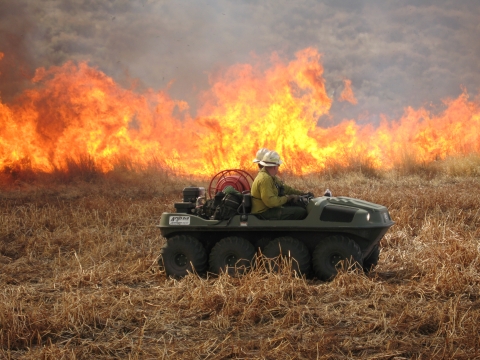“The mission of the U.S. Fish and Wildlife Service and the fuels management work we do is why I chose to make a career in fire,” shares Josh O’Connor, the Regional Fire Management Coordinator for the U.S. Fish and Wildlife Service’s (Service) Pacific Region. Fuels are anything that can burn. During a wildland fire, plant material can act as fuel and excess fuel can allow fires to quickly become catastrophic. The strategic removal of grasses, shrubs, and trees can reduce the impacts of wildfire and – it can also restore and maintain ecosystems.
As the Regional Fire Management Coordinator, O’Connor oversees the fire program in the region, which is responsible for both fire suppression and prescribed fire. He prioritizes regional fire management budgets, staffing plans, wildfire response priorities, and hiring priorities. O’Connor’s focus is ensuring firefighters in the Pacific Region receive required training, supplies, and support they need to do their jobs safely.
O’Connor started his career in fire management as a seasonal firefighter. First stationed at Malheur National Wildlife Refuge in Oregon, O’Connor traveled all over the Northwest – Idaho, California, Washington, and Oregon – during his first summer working with the Service. Next he worked as a seasonal firefighter at Florida Panther National Wildlife Refuge in Florida, applying prescribed fire at the refuge to restore long-leaf pine habitat.
“That first winter in Florida, I was part of a team that applied 20 to 30 prescribed fires in two short months, then fought wildfires in the spring. I truly believe in the benefits of prescribed fire and preventative management and it’s what keeps me dedicated to the wildland fire job series,” said O’Connor.
Fuels Management
Many habitats, plants, and even wildlife evolved to depend on periodic, low intensity fires to thrive. Conservation managers can mimic those natural events using prescribed fires. The right kind of fire, applied safely, is a vital element for sustaining healthy habitat and preventing wildfires. Not only does low-intensity fire, like prescribed fire, reduce fuels, it also sustains and enhances wildlife habitat and food sources for the thousands of wildlife species that take refuge on National Wildlife Refuge System managed lands.
From marsh to forest to prairie, 80% of the public lands the Service is responsible for have evolved with fire, many depend on periodic fire to remain productive wildlife habitat and healthy landscapes. In fact, 50% of all prescribed fire acres applied by Department of the Interior bureaus are applied by the Service. In fiscal year 2022, the Pacific Region fire program treated over 20,000 acres of land, reducing hazardous fuels and the risk of wildfire and helping restore wildlife habitat.
Not only does the application of prescribed fire benefit plant and animal species and reduce risk of wildfire by reducing fuel loading, it also allows firefighters to practice wildland fire management operations while learning fire behavior in a controlled setting. This type of on-the-ground training can be crucial once wildfire seasons begin.
The 2023 wildfire season in the Northwest is predicted to be above normal starting around July, mostly due to above-normal temperatures and below normal precipitation levels across much of the region. As the regional representative to numerous interagency fire and management teams, O’Connor works with other federal, state, and Tribal agencies to prioritize the fire response in the region.
In recent years, the United States is experiencing extreme wildfires more frequently. Extreme heat, drought and expanding development in the wildland urban interface have all made the situation worse. The wildland urban interface is the line, area, or zone where structures and other human development meet or intermingle with undeveloped wildland or vegetative fuels. Last year alone, almost 69,000 wildfires burned more than 7.5 million acres across the nation.
Careers in Wildland Firefighting
Although fighting fire is physically demanding, a career in wildland fire is rewarding. Being a wildland firefighter means getting to see places many people never will, being part of a team, building friendships that last a lifetime, and being a part of something that affects people, landscapes, habitats, and wildlife species for the better.
“Entering into firefighting as a seasonal firefighter provides so many opportunities to experience what it’s truly like before making a longer commitment,” expresses O’Connor. As a manager and supervisor twenty-five years into his career, O’Connor prioritizes professional development and training, mental and physical health and safety, and working for tangible changes to the hiring process to make recruitment and retention easier.
“Working for the Service provides opportunities for employees to develop various skillsets,” O’Connor said. “If there’s a learning opportunity you are interested in, there will almost always be support, especially when it comes to on-the-job experiences and investing into your future. This level of support is one of the reasons I am where I am today.”
There are many different jobs and career paths as a part of the fire program: working in dispatch or logistics, providing communications support as a public information officer, becoming a biologist with an emphasis in fire management, working as a fire budget analyst – the possibilities are endless. Nationally, the fire program employs over 350 permanent and 1,000 seasonal fire personnel.
The U.S. Fish and Wildlife Service’s wildland fire program regularly hires throughout the year. If you are interested in applying for a wildland fire position or would like to learn more visit https://www.fws.gov/program/fire-management or find us on Facebook and Twitter at @USFWSFire.
*This story was written collaboratively with Jan Peterson for the Pacific Region of the U.S. Fish and Wildlife Service.





